Abstract
The properties of synapses between retinal neurons make an essential contribution to early visual processing. Light produces a graded hyperpolarization in photoreceptors, up to 25 mV in amplitude1, and it is conventionally assumed that all of this response range is available for coding visual information. We report here, however, that the rod output synapse rectifies strongly, so that only potential changes within 5 m V of the rod dark potential are transmitted effectively to postsynaptic horizontal cells. This finding is consistent with the voltage-dependence of the calcium current presumed to control neurotransmitter release from rods2. It suggests functional roles for the strong electrical coupling of adjacent rods3 and the weak electrical coupling of adjacent rods and cones4. The existence of photoreceptor coupling resolves the apparent paradox that rods have a 25 mV response range, while signals greater than 5 mV in amplitude are clipped during synaptic transmission. We predict that the strengths of rod-rod and rod-cone coupling are quantitatively linked to the relationship between the rod response range and the synapse operating range.
This is a preview of subscription content, access via your institution
Access options
Subscribe to this journal
Receive 51 print issues and online access
$199.00 per year
only $3.90 per issue
Buy this article
- Purchase on Springer Link
- Instant access to full article PDF
Prices may be subject to local taxes which are calculated during checkout
Similar content being viewed by others
References
1. Bader, C. R., MacLeish, P. R. & Schwartz, E. A. Proc. natn. Acad. ScL U.S.A. 75, 3507–3511 (1978). 2. Bader, C. R., Bertrand, D. & Schwartz, E. A. J. Physiol., Lond. 331, 253–284 (1982). 3. Attwell, D. & Wilson, M. /. Physiol., Lond. 309, 287–315 (1980). 4. Attwell, D., Wilson, M. & Wu, S. M. J. Physiol., Lond. 352, 703–737 (1984). 5. Hanani, M. & Vallerga, S. 7. Physiol., Lond. 298, 397–405 (1980). 6. Marshall, L. M. & Werblin, F. S. 7. Physiol., Lond. 279, 321–346 (1978). 7. Attwell, D. Q. 7. exp. Physiol. 71, 497–536 (1986). 8. Shiells, R. A., Falk, G. & Naghshineh, S, Proc. R. Soc. Lond. B 227, 121–135 (1986). 9. Custer, N. V. 7. comp. Neurol. 151, 35–56 (1973). 10. Falk, G. & Fatt, P. Handbook of Sensory Physiology Vol. VII/1 (ed. Dartnall, H. J. A.) 235–239 (Springer, Heidelberg, 1972). 11. Lamb, T. D. & Simon, E. J. 7 Physiol., Lond. 263, 257–286 (1971). 12. Baylor, D. A., Lamb, T. D. & Yau, K. W. 7. Physiol., Lond. 288, 589–611 (1979). 13. Attwell, D., Werblin, F. S. & Wilson, M. 7. Physiol., Lond. 328, 259–283 (1982). 14. Werblin, F. S. 7 Physiol, Lond. 280, 449–470 (1978). 15. Normann, R. A. & Perlman, I. 7 Physiol., Lond. 286, 509–524 (1979). 16. Attwell, D., Wilson, M. & Wu, S. M. Brain Res. 343, 79–88 (1985).
Author information
Authors and Affiliations
Rights and permissions
About this article
Cite this article
Attwell, D., Borges, S., Wu, S. et al. Signal clipping by the rod output synapse. Nature 328, 522–524 (1987). https://doi.org/10.1038/328522a0
Received:
Accepted:
Issue Date:
DOI: https://doi.org/10.1038/328522a0
This article is cited by
-
Interphotoreceptor coupling: an evolutionary perspective
Pflügers Archiv - European Journal of Physiology (2021)
-
Transmission at rod and cone ribbon synapses in the retina
Pflügers Archiv - European Journal of Physiology (2021)
-
Kinetics of Synaptic Transmission at Ribbon Synapses of Rods and Cones
Molecular Neurobiology (2007)
-
Rod outer segments are designed for optimum photon detection
Biological Cybernetics (1992)
Comments
By submitting a comment you agree to abide by our Terms and Community Guidelines. If you find something abusive or that does not comply with our terms or guidelines please flag it as inappropriate.



